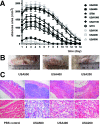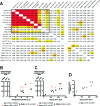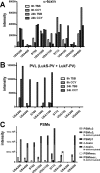Comparative analysis of virulence and toxin expression of global community-associated methicillin-resistant Staphylococcus aureus strains
- PMID: 21050125
- PMCID: PMC3058913
- DOI: 10.1086/657419
Comparative analysis of virulence and toxin expression of global community-associated methicillin-resistant Staphylococcus aureus strains
Abstract
The current pandemic of community-associated methicillin-resistant Staphylococcus aureus (CA-MRSA) skin infections is caused by several genetically unrelated clones. Here, we analyzed virulence of globally occurring CA-MRSA strains in a rabbit skin infection model. We used rabbits because neutrophils from this animal species have relatively high sensitivity to Panton-Valentine leukocidin (PVL), a toxin epidemiologically correlated with many CA-MRSA infections. Virulence in the rabbit model correlated with in vitro neutrophil lysis and transcript levels of phenol-soluble modulin α and α-toxin, but not PVL genes. Furthermore, abscesses caused by USA300 and its PVL-negative progenitor USA500 were comparatively large and similar in size, suggesting that PVL has played a limited role in the evolution of USA300 virulence in the context of skin infections. Our study indicates a major but not exclusive impact of virulence on the epidemiological success of USA300 and other CA-MRSA strains and emphasizes the importance of core genome-encoded toxins in CA-MRSA skin infections.
Figures







References
-
- Lowy FD. Staphylococcus aureus infections. N Engl J Med. 1998;339:520–532. - PubMed
-
- Daum RS, Ito T, Hiramatsu K, et al. A novel methicillin-resistance cassette in community-acquired methicillin-resistant Staphylococcus aureus isolates of diverse genetic backgrounds. J Infect Dis. 2002;186:1344–1347. - PubMed
Publication types
MeSH terms
Substances
Grants and funding
LinkOut - more resources
Full Text Sources
Other Literature Sources
Medical

